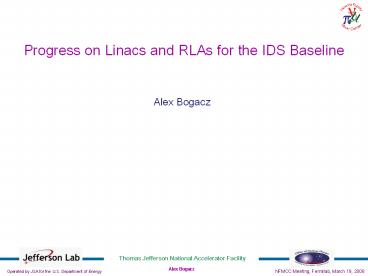Berkeley Lab Generic Presentation PowerPoint PPT Presentation
Title: Berkeley Lab Generic Presentation
1
Progress on Linacs and RLAs for the IDS Baseline
Alex Bogacz
2
Neutrino Factory ISS/IDS Baseline
3
Acceleration Scenario ISS/IDS Baseline
- Linear Pre-accelerator (244 MeV to 900 MeV)
- RLA I - 4.5 pass, 0.6 GeV/pass, (0.9 GeV to 3.6
GeV ) - RLA II - 4.5 pass, 2 GeV/pass (3.6 GeV to 12.6
GeV ) - Non scaling FFAG (12.6 GeV to 25 GeV )
4
Acceleration Scheme IDS Goals
- Engineering design foundation
- Define beamlines/lattices for all components
- Design lattices for transfer lines between the
components - Resolve physical interferences, beamline
crossings etc ? Floor Coordinates - Carry out end-to-end tracking study ? Machine
Acceptance - Engineer individual active elements (magnets and
RF cryo modules)
5
Towards Engineering Design Foundation
6
Arcs Crossing - Vertical Bypass
7
Initial beam emittance after the cooling at 220
MeV/c
ISS/IDS erms A (2.5)2 e
normalized emittance ex/ey mm?rad 4.8 30
longitudinal emittance el (el sDp sz/mmc) momentum spread sDp/p bunch length sz mm mm 27 0.07 176 150 ?0.17 ?442
8
Pre-accelerator - different style cryo-modules
Short Medium Long
Number of periods 6 8 11
Total length of one period 3 m 5 m 8 m
Number of cavities per period 1 1 2
Number of cells per cavity 1 2 2
Cavity accelerating gradient 15 MV/m 17 MV/m 17 MV/m
Real-estate gradient 3.72 MV/m 5.06 MV/m 6.33 MV/m
Aperture in cavities (2a) 460 mm 460 mm 460 mm
Aperture in solenoids (2a) 460 mm 460 mm 460 mm
Solenoid length 1 m 1 m 1 m
Solenoid maximum field 1.1 T 1.4 T 2.5 T
9
Linear Pre-accelerator 244 MeV to 909 MeV
8 medium cryos
6 short cryos
11 long cryos
10
Introduction of synchrotron motion in the linac
Longitudinal acceptance Dp/p?0.17 or Df ?93
(200MHz)
11
Linear Pre-accelerator Longitudinal dynamics
Transverse acceptance (normalized) TA
(2.5)2eN 30 mm rad
Longitudinal acceptance LA (2.5)2 sDpsz/mmc
150 mm
12
Injection double-chicane
m
m-
13
Pre-acceleratorChicaneLinac Matching
14
RLA I Linac Longitudinal Dynamics
a 210-5
15
Linear Pre-accelerator RLA complex
16
Dogbone RLA with FODO Focusing
- RLA requirements
- Simultaneous acceleration of both m m- species
- Manageable orbit separation at recirculation
arcs - Beam dynamics challenges - RLA Optics solutions
- Phase slippage in the linacs
- Multi-pass linac optics
- Orbit separation linac ends
- Droplet return arc compact lattice design
17
RLAs for Muon Acceleration
- Dogbone (Single Linac) RLA has advantages over
the Double-Linac RLA Racetrack - better orbit separation at linacs end energy
difference between consecutive passes (2DE) - allows both charges to traverse the Linac in the
same direction (more uniform focusing profile - the droplets can be reduced in size according to
the required energy - FODO Optics is superior to Triplet focusing -
more passes are possible with the FODO scheme
18
Phase slippage in the linac
- Phase slippage of a semi-relativistic muon beam
injected with the initial energy E0 and
accelerated by DE in a linac of length, L -
assuming uniformly spaced RF cavities phased for
a speed-of-light particle - The injection energy, E0 , needs to be chosen, so
that a tolerable level of the RF phases slippage
along the main linac can be maintained (40 deg).
19
Phase slippage in the RLA linac
RLA I (0.6 GeV/pass)
RLA II (2 GeV/pass)
RF phase slippage along the multi-pass linacs
initial gang phases for each pass were chosen
for the optimum longitudinal bunch compression in
each linac-Arc segment
20
Multi-pass Linac Optics
- The focusing profile along the linac (quadrupole
gradients) need to be set so that one can
transport multiple pass beams within a vast
energy range (provide adequate transverse
focusing for given aperture) . - The beam is traversing the linac in both
directions - one chooses a flat focusing
profile (Bob Palmer) for the entire linac e.g.
the quads in all cells are set to the same
gradient, corresponding to 90 deg. phase advance
per cell determined for the lowest energy
(injection) no quad scaling with energy - The requirement of simultaneous acceleration of
both m species imposes mirror symmetry of the
droplet Arcs optics (the two species move in
the opposite directions through the Arcs). This
in turn puts a constraint on the exit/entrance
Twiss functions for the two consecutive linac
passes - boutn binn1 and aoutn -ainn1
where n 0, 1, 2.. is the pass index
21
FODO - flat focusing' linac profile
half pass , 900-1200 MeV
initial phase adv/cell 90 deg fixed gradient in
all cells (no scaling with energy)
Linac cryo-module solenoid replaced with a quad
1-pass, 1250-1800 MeV
phase adv. diminish uniformly in both planes
22
FODO - flat focusing' linac profile
2-pass, 1800-2400 MeV
phase adv. diminish uniformly in both planes
3-pass, 2400-3000 MeV
23
FODO - flat focusing' linac profile
4-pass, 3000-3600 MeV
phase adv. still larger then 180 deg. in both
planes
24
Mirror-symmetric Droplet Arc Optics
(bout bin ,and aout -ain , matched to the
linacs)
2 cells
2 cells
16 cells
25
Summary
- IDS Goals laying engineering design foundation
- Define beamlines/lattices for all components
- Design lattices for transfer lines between the
components - Resolve physical interferences, beamline
crossings etc ? Floor Coordinates - Carry out end-to-end tracking study ? Machine
Acceptance - Implementing chromatic corrections with
sextupoles - Engineer individual active elements (magnets and
RF cryo modules) - Element count and costing

